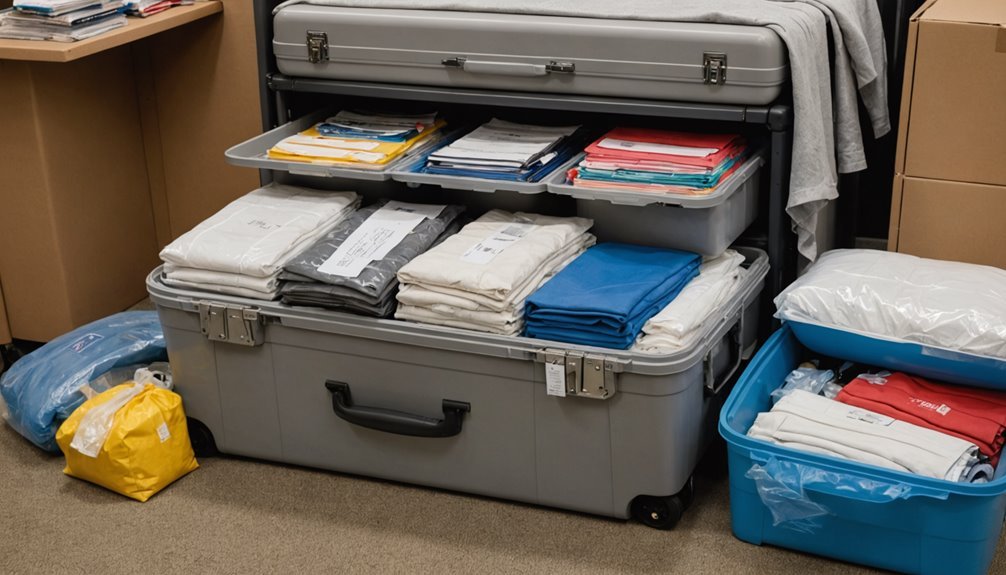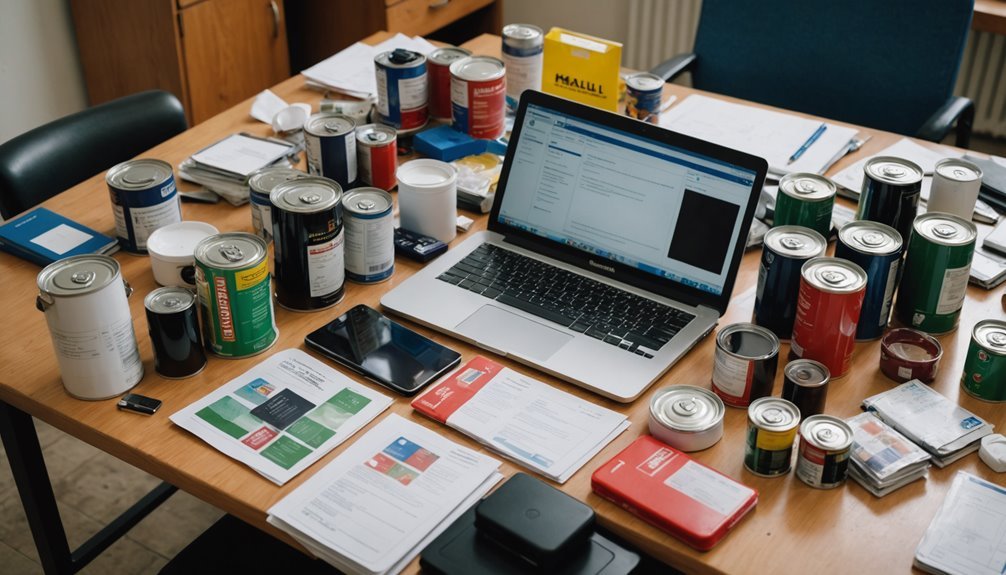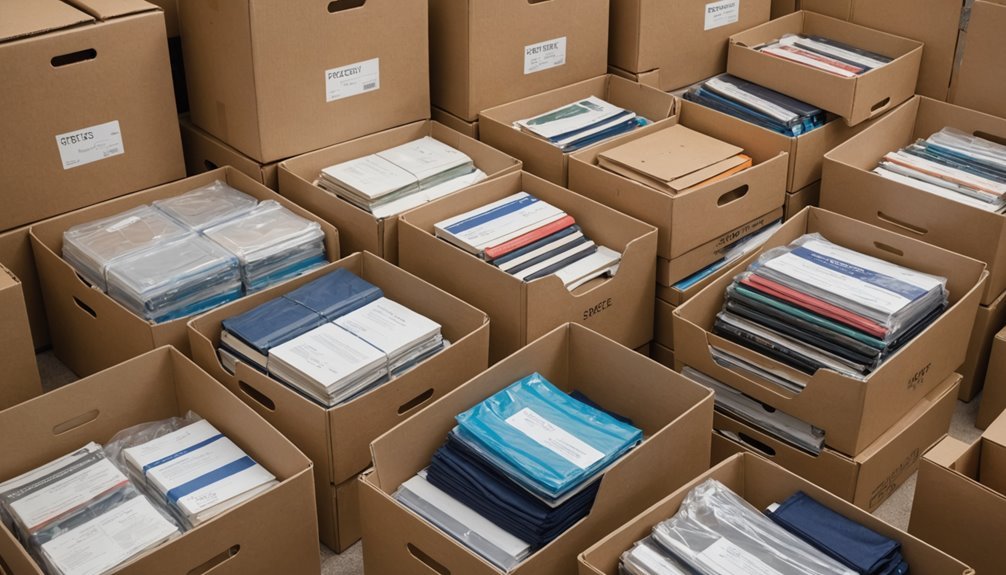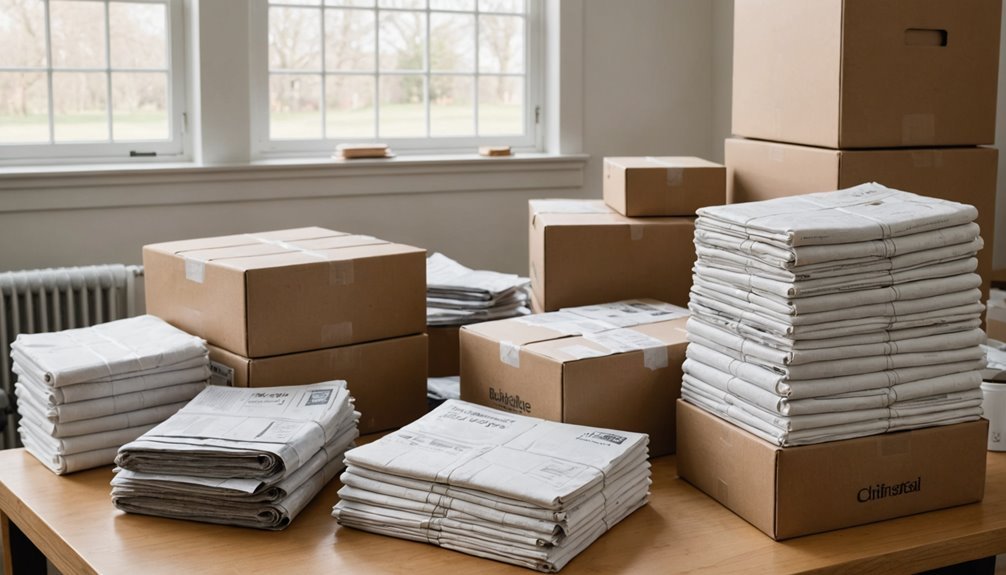When you're gearing up for a move, knowing a few clever packing hacks can greatly ease the process. You've probably faced the common struggles—boxes busting open, scrambling for items you need immediately upon arrival, or realizing too late that your fragile items weren't packed securely. Employing strategies like keeping your clothes on hangers and using your socks to cushion breakables might sound simple, yet they're game-changers. But these tips are just the tip of the iceberg. Imagine what you could achieve with a full arsenal of such tricks up your sleeve—why stop at just these few?
Key Takeaways
- Utilize bubble wrap and soft linens to securely wrap fragile items, preventing breakage during the move.
- Pack dishes and glassware vertically with ample cushioning to avoid crushing.
- Keep clothes on hangers and cover with garbage bags for easy, wrinkle-free transport.
- Label boxes clearly with contents and room destination, using bold markers for fragile items.
- Schedule grocery delivery close to your move-in date to simplify meal planning and reduce immediate shopping needs.
Declutter Before Packing
Before you begin packing for your move, it's important to declutter your home. Start this process at least six weeks ahead to guarantee you have enough time to thoroughly evaluate what you need to keep, donate, or discard.
This early start not only simplifies your packing but also enhances organization in your new space.
Focus on reducing your belongings by sorting them into three categories: keep, donate, and discard. Aim to cut down your items by 20-30%.
By doing so, you'll need fewer packing materials and boxes, making the move smoother and more cost-effective.
When deciding what stays and what goes, use the "one-year rule." If you haven't used an item in the past year, it's probably time to let it go.
This approach guarantees that you only move items that are truly necessary.
Consider donating your gently used items. Many local charities offer free pick-up services for larger items, making it convenient to donate and reduce your load.
Keep Clothes on Hangers
Keeping your clothes on hangers during a move not only simplifies the transportation process but also helps reduce wrinkles. This strategy lets you effortlessly transfer your wardrobe essentials straight from one closet to another.
By using garbage bags as a protective cover over your hung clothes, you shield them from dirt and possible damage during the move. Simply slip a garbage bag over a group of hangers, and secure it at the top. This method isn't only efficient packing but also guarantees your clothes stay clean and organized.
Additionally, keeping your clothes on hangers means you'll use fewer packing materials, reducing overall clutter. This approach minimizes the need for boxes and eliminates the tedious task of folding and later ironing your garments.
When you arrive at your new home, you can quickly access your key outfits and start settling in right away. Just remove the garbage bags, and hang your clothes directly in your new closet.
It's a straightforward way to keep your moving day stress-free and keep your focus on enjoying your new space. With this hack, unpacking becomes a breeze, letting you feel at home sooner.
Utilize Packing Photos

Utilizing packing photos can greatly streamline your moving process. By taking pictures of how you've arranged your knick-knacks or decor, you can easily recreate the setup in your new home. It's like having a personal blueprint for where everything should go, reducing the guesswork and adjustment time once you arrive.
Documenting the contents of each box with photos creates a visual inventory that's invaluable. Imagine not having to tear through multiple boxes to find your favorite coffee mug; a quick glance at your photos tells you exactly where it is. This method not only organizes your move but also speeds up the unpacking process.
Don't forget to snap shots of your electronic setups before you disassemble them. These photos guarantee you can set up your devices just as they were, without any confusion about where each cable goes. It's a simple step that can prevent a lot of frustration later.
Moreover, packing photos are essential for insurance purposes. If anything is damaged during the move, having detailed images of your items' prior condition can help substantiate your claim, making certain you're covered.
Use Clothing as Cushion
When packing for a move, consider using your bulky clothing to protect fragile items. Wrapping your delicate decor or glassware in winter coats, sweaters, or towels isn't just a packing hack; it's a smart way to cushion these items against bumps and drops during transport.
This technique not only saves you from buying bubble wrap but also maximizes space in your moving boxes, making your packing more efficient. You can use the sleeves of sweatshirts to snugly secure larger pieces, like vases or picture frames, which helps prevent them from shifting and getting damaged.
Since you're using clothes that need to be packed anyway, this strategy reduces the number of boxes you need and consequently minimizes the overall weight of each box. That makes them easier to lift and move.
Moreover, integrating clothes into your packing routine helps streamline unpacking at your new home. You'll have fewer boxes to deal with, and you can easily access and sort your clothing.
Label Wires and Tools

After you've packed your fragile items using clothing, it's time to tackle the smaller, easily tangled mess of wires and tools. To make your move as smooth as possible, it's vital to organize tools and wires meticulously. Start by gathering all your wires and sort them based on their corresponding devices or furniture. Place each set in labeled Ziploc bags. This organization trick will guarantee you won't lose your mind trying to figure out which wire goes where when setting up at your new home.
Additionally, remember to label each bag clearly with packing tape. Include details like the device name and a brief description if necessary. Store any accompanying instruction manuals and small parts like screws in the same labeled bags. This method keeps all necessary components together, saving you the frustration of searching through boxes later.
For your tools, designate a specific box or bag for storing essential tools. This designated box should be clearly marked and easily accessible during both the packing and unpacking phases.
| Emotion | Why It Matters |
|---|---|
| Relief | No tangled wires mess |
| Satisfaction | Everything is organized |
| Confidence | Essential tools are at hand |
| Peace of Mind | Quick setup at new location |
These steps will not only save you time but will also spare you needless stress during your move.
Pack Using All Bags
Often overlooked, suitcases, duffle bags, and backpacks are your best allies when maximizing space during a move. By choosing to pack using all bags, you'll greatly reduce the number of boxes you need, making your move more streamlined and organized.
Start by folding your clothes neatly into these bags. Use the nooks and crannies for packing smaller items like accessories or electronics, which not only saves space but also enhances organization.
Sturdy luggage is perfect for heavier items. Their built-in wheels will help you move them around effortlessly, which is a boon when you're dealing with the physical strain of moving.
Assemble an Essentials Box

Why not simplify your move by assembling an essentials box? This box should contain immediate necessities like chargers, a change of clothes, toiletries, and important documents, ensuring you have easy access to these items during your move.
By doing this, you'll minimize stress and make the shift into your new space smoother.
When packing, keep the essentials box separate and pack it last. This strategy makes sure these vital items are the last ones packed and the first ones you can reach.
You'll appreciate not having to rummage through multiple boxes after a long day of moving.
Don't forget to clearly label the essentials box. A conspicuous label helps you quickly identify it among the sea of other boxes, facilitating a hassle-free start at your new home.
Consider what you'll need for the first few days post-move. Including these items can greatly streamline your post-move routine, allowing you to settle in without missing a beat.
A well-prepared essentials box not only keeps your important items within reach but also serves as a personal survival kit that caters to your immediate needs as you adjust to your new surroundings.
Schedule Grocery Delivery
While you've secured your immediate necessities in an essentials box, don't overlook the importance of having food ready at your new home. Schedule grocery delivery for a day or two before your move to make sure essential food items are waiting for you. This approach not only makes your arrival less stressful but it also allows you to focus more on unpacking and settling in.
Using grocery delivery services can greatly enhance the efficiency of your moving process. These services offer convenient options for selecting delivery windows, ensuring that your groceries arrive when you're ready to receive them. You won't need to squeeze in a trip to the store amidst the chaos of moving day.
To streamline this process even further, create a shopping list in advance. Think about the meals you'll want in the first few days—breakfast items, easy lunches, and simple dinners. Having these essential items on hand means you can feed yourself and your helpers without having to rummage through boxes or rush to the nearest store.
Identify Non-Packable Items

As you prepare for your move, it's crucial to recognize which items shouldn't be packed. Identifying non-packable items early can save you a lot of hassle.
Start by considering perishable food, especially open packages. These items can attract pests and spoil, making them unsuitable for packing. Instead, plan to consume or donate them before your move.
Valuables like jewelry, collectibles, and cash also need special attention. It's safer to keep these items with you during the move to prevent any loss or theft.
Similarly, irreplaceable documents such as personal IDs, medical records, and wills should be kept accessible and not packed away in boxes. You'll need these documents handy for verification purposes at your new location.
Furthermore, be cautious with flammable items. Products such as paint, solvents, and batteries pose serious safety risks and are typically forbidden by movers.
The same caution applies to gardening supplies like weed killers and insecticides. These items can be hazardous and are best disposed of properly rather than packed.
Taking care to sort and manage these non-packable items will promote a smoother, safer moving experience.
Organize Packing Timeline
Kick off your packing process by crafting a detailed timeline six weeks prior to your move. To reduce the stress, start with decluttering during the initial three weeks. It's the perfect time to sort through your belongings and decide what to keep.
Simultaneously, begin to gather supplies like boxes and packing tape. These early steps are essential in your packing timeline, ensuring you're not overwhelmed as moving day approaches.
Next, utilize a packing checklist to organize your tasks week by week. Pack non-essential items first, gradually moving to those you use more frequently. This method keeps you organized and prevents last-minute chaos.
Keep your frequently used items accessible until the final days, adjusting your packing checklist as necessary to accommodate your daily needs.
If you're under a tight schedule, dedicate a full day to each major task—decluttering, gathering supplies, and packing. This compressed timeline can help streamline the process and keep things manageable.
Choose Boxes or Totes

After setting up your packing timeline, your next step is to decide whether to use boxes or totes for your belongings. Boxes are generally cheaper and available in various sizes, making them ideal for a wide range of items. However, they may require tape for sealing and can fall apart if wet.
On the other hand, totes are more durable and reusable, but they're pricier and might crack under heavy weight.
When packing, consider using small boxes for heavy items like books to prevent breakage, and reserve large boxes for lighter items. This strategy not only guarantees the safety of your items but also optimizes space in the moving truck. Since boxes can be easily stacked, they help maximize your packing and moving efficiency.
For items you plan to store or move repeatedly, totes are a better choice due to their durability and reusability. Although more of an initial investment, they can be a wise choice for long-term use.
Mixing both boxes and totes can optimize your packing time, leveraging the strengths of each based on the items you're moving. This approach allows you to customize your packing strategy to your specific needs, ensuring an effortless move.
Donate Unwanted Items
Before you begin packing for your move, consider donating items you no longer need. Donating not only declutters your home but also simplifies the packing process. Fewer belongings mean you'll reduce box count and make your move easier. Additionally, your unwanted items can have a charitable impact, helping those in need while providing you with potential financial benefits through tax deductions.
Here's a quick guide on what you can donate and where:
| Items | Accepting Organizations | Benefits |
|---|---|---|
| Clothes | Goodwill, Salvation Army | Declutters, Tax Deductible |
| Furniture | Habitat for Humanity | Free Pickup, Charitable Impact |
| Electronics | Best Buy, Local Charities | Eco-Friendly, Tax Deductible |
| Household Goods | Salvation Army, Goodwill | Declutters, Charitable Impact |
| Unopened Food | Move for Hunger, Food Banks | Prevents Waste, Helps Needy |
Reuse Packing Materials

When you're gearing up to move, consider reusing packing materials to save money and reduce waste. Immerse yourself in your stash of used boxes from previous deliveries, ensuring they're still sturdy and clean. This simple step not only cuts costs but also reduces your environmental footprint.
Don't overlook everyday items like plastic grocery bags, which can be excellent for cushioning your belongings. Stuff them into glasses, wrap around vases, or use them as a buffer between stacked dishes. They're surprisingly effective and readily available.
Similarly, old newspapers and magazines serve well as packing filler. They provide solid protection for your items, keeping them secure during the move, and you're recycling paper that might otherwise be thrown away.
Additionally, consider more sustainable options like renting plastic moving boxes. These reusable containers are sturdy and can handle heavier loads much better than cardboard. Plus, they come from rental companies that often provide labels to help with organization—a topic for another section.
Manage Inventory With Labels
Building on the theme of organization, labeling your boxes effectively can dramatically streamline your moving process. By assigning color-coded labels to each box according to which room it's destined for, you'll simplify the task of sorting and unpacking.
Make certain each label includes a brief description of the contents inside. This way, you won't waste time guessing what's in each box, and you can guarantee everything goes directly to its intended spot.
To further manage your inventory, create a detailed spreadsheet that records what's in every box. This digital inventory can be a lifesaver, helping you quickly locate items when you start unpacking. It's also a great tool to guarantee nothing gets lost or misplaced during the move.
Opt for clear, waterproof labels to withstand any moisture they might encounter during transit.
For a modern twist, consider using QR code labels that link directly to your digital inventories. This high-tech solution allows you to access the contents of each box with just a scan, making it easier to identify and retrieve specific items without rummaging through multiple boxes.
Protect Fragile Items

Guaranteeing your fragile items' safety during a move is vital. Start by wrapping your dishes and glassware in bubble wrap or soft linens. This step not only protects them but also greatly reduces the risk of breakage during transport. To further ensure the security of your breakables, consider using sturdy boxes with dividers specifically designed for fragile goods. Clearly labeling these boxes as “Fragile” will alert movers to handle them with extra care. By combining these strategies with other safe ways to move fragile items, you can significantly minimize damage and keep your valuables intact.
When you're packing these items, don't stack them horizontally. Instead, pack them vertically. This method prevents crushing and enhances their safety throughout the move.
For your stemware and smaller fragile items, wine boxes are ideal. They offer compartmentalized protection that minimizes movement and impact, guaranteeing your items stay secure.
If you're transporting artwork or mirrors, first create an "X" with masking tape across the glass. This simple trick helps to prevent shattering. Don't forget to wrap them in moving blankets for added cushioning and protection.
Always clearly label your boxes containing fragile items. Marking them with a bold "FRAGILE" guarantees that movers and helpers handle them with extra care.
Frequently Asked Questions
How to Make Packing for a Move Easier?
To make packing for a move easier, start early and use a moving checklist.
Employ decluttering strategies before you pack to manage your time effectively. Organize your packing supplies and tackle each space room by room.
Implement labeling systems on your boxes for easy identification. Keep essential items accessible.
These organization tips, along with a systematic approach, will streamline your moving process, making it more manageable and less overwhelming.
How Do I Make My Packing Not Overwhelming?
To make packing less overwhelming, start by decluttering and using a detailed checklist. Tackle one room at a time, prioritizing non-essentials.
Utilize color-coded labels for easy box identification and organize items systematically. Manage your time by scheduling specific days for different areas.
Don't forget to pack an essentials box for immediate needs. Remember, emotional support is key, so involve friends or family to help lighten the load and keep spirits high.
How to Pack for a Trip Without Getting Overwhelmed?
To pack for a trip without getting overwhelmed, start by creating a packing list including travel essentials like toiletries and versatile clothes.
Organize your suitcase using packing cubes for better management.
Adopt a clothing strategy that involves rolling items to save space.
Keep your toiletries in a separate accessible pouch.
Finally, pack an essentials bag with last-minute items to grab quickly.
This approach keeps things manageable and stress-free.
What Is the Hardest Room to Pack When Moving?
The hardest room to pack when moving is typically the kitchen. You've got to juggle fragile dishes, various appliances, and sharp knives.
Bedroom organization also takes time, sorting through clothes and personal items.
Living room strategies must account for bulky furniture and electronics.
Don't overlook the bathroom essentials and garage tools, which require careful handling.
Make certain you've got enough moving supplies to protect and label everything from closet items to kitchen packing necessities.
Conclusion
As you gear up for your move, remember these hacks to make the process smoother. Declutter first to lighten your load, keep clothes on hangers, and snap photos to remember setups. Use your clothes as cushioning and label everything, especially fragile items. Donating what you don't need minimizes waste, and reusing materials saves money. With a bit of organization and creativity, you'll find moving isn't just easier; it's more efficient. Happy moving!


